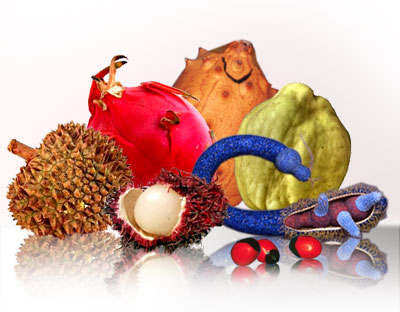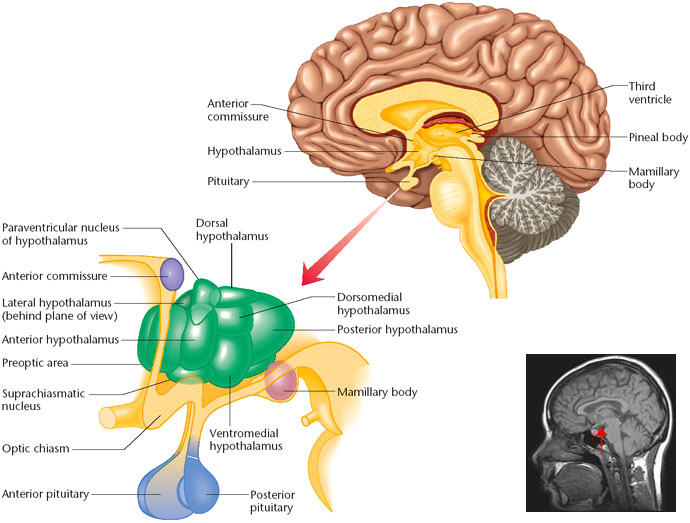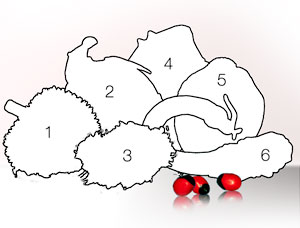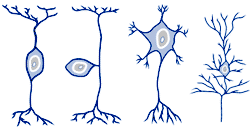1.1 The Study of Survival & Self Indulgence

A Thought Primer.
Imagine you are trapped in a cave with three other people, one of whom is semi-conscious, and appears to be quite ill, possibly dying. There is no food except for a collection of strange and unusually coloured 'fruit'. None of the 'fruits' are familiar or look particularly appetising, some having colours and textures suggestive of toxicity. But you are slowly starving to death and there is no way out of the cave. What do you do?
Responses to this predicament do not always bring out the best in people. When giving a lecture about smell & taste to a small group of high powered bankers, one suggested we should forget the berries, knock off the dying man and eat him!(I decided that he was definitely senior management material and warned the CEO to watch his back.)
My introduction is a philosophical thought primer - there are no right or wrong answers. It serves only to illustrate our impotence before dilemmas of smell and taste. It also poses questions,"Are our senses of smell and taste necessary for survival? To what extent are they mere 'pleasure receptors' - an impetus to indulge?" The answers to these questions are not straightforward. Smell and taste are profoundly mysterious senses and the more we investigate their workings, the more we realize how little we know about them. The object of this section is to understand how the senses of smell and taste work, how they impact upon our survival , and then finally, where indulgence fits into the scheme of things.
For life to be sustained and continue to grow there are many conditions that must pre-exist. These pre-requisites are interconnected, and if any of the environmental or personal conditions are removed or diverge too much from the broad range that is necessary for survival, then existence is placed at risk. These conditions can be briefly outlined in four categories:
1) Environmental Requirements
| a) | Temperature / sunshine | - a relatively small temperature variation range. |
| b) | Air quality | - clean air is important for long term health standards to be maintained. |
| c) | Humidity | - a relatively small range of humid conditions for long term existence. |
| d) | Radiation | - freedom from high levels of radioactivity. |
| e) | Toxicity | - toxic materials, leaks/spills/landfills all impact on the ability to sustain long term habits. |
| f) | Absence of (or refuge from) natural & unnatural disasters | - disasters destroy entire communities and ecosystems and may also alter the mix of the gene pool. |
| g) | Balanced eco-system | - alter the balance of the environment for a sustained period and irreversible damage may occur. The existence of a wide variety of plants and animals must be in balance with the ecosystems. |
| h) | Soils | - the breakdown of rocks into soil and their capacity to anchor down plants and nourish their existence. |
| i) | Water | - the availability of water is paramount for life to exist. |
| j) | Plants | -The necessity for photosynthesis to continue on a level to support the conversion of carbon dioxide to oxygen. |
2) Continuity of the Species
| a) | The presence of a diverse gene pool. (1) |
| b) | The presence of fertile partners. |
3) Personal Survival
| a) | Shelter from elements of the environment. |
| b) | The need to maintain a homeostatic body condition. |
| c) | The presence and availability of clean drinking water. |
| d) | The availability of food. |
| e) | In the world today: Money. |
You will notice that a sense of smell and taste are not included in any of the above categories. It is possible in our modern times, alleviated by strict Health and Safety regulations, to get by without these senses, as sufferers of anosmia do (a condition of complete odour blindness). On the other hand, absolute or even partial anosmia in primitive peoples would mean ones chances of survival were considerably reduced. It may be a mistake not to classify the senses of smell and taste as pre-requisite for survival - that is what we are going to investigate.
Smell and taste are synonymous with water and food, and water and food are synonymous with survival. But in the bodies quest for survival, the need for water is paramount over the need for food. We are, after all, essentially a collection water-filled cells enveloped by skin. Unlike fats, most organisms cannot store appreciable amounts of water. The human body loses naturally around 2-3 litres of liquid per day which it must replace. As a rule of thumb, our daily water requirements are dictated by our calorie loss; for example, if we burn 2000-3000 calories per day, we will require 2-3 litres of water per day. In part, this renewal is to keep the salt levels within the body balanced. A loss of water has the effect of concentrating the body salts such as sodium and potassium, which upon reaching a high level of concentration in the body bring about a heart attack.
The Hypothalamus
To prevent dehydration, we possess a critical 'master over-ride switch': The hypothalamus (pictured below). The fundamental function of the hypothalamus is homeostasis, or maintaining the body's constant internal conditions. Factors such as blood pressure, body temperature, body weight, fluid and electrolyte balance are held to a precise theoretical value called the set-point. Although this set-point can migrate over time, from day to day it is remarkably fixed.
In humans the hypothalamus is located in the middle of the base of the brain above the roof of the mouth, projecting downward ending in the stalk of the pituitary gland. The two are intimately connected and it is difficult to overstate the influence of hypothalamic and pituitary hormones over physiologic processes. The target cells for most of the hormones produced in these tissues are themselves endocrine cells, and a seemingly small initial signal is thus amplified to cause widespread effects on many cells and tissues.(2)To achieve this task, the hypothalamus must receive inputs about the state of the body and must be able to initiate compensatory changes.

The Hypothalamus: Its location also indicated by a red dot in the fMRI scan inset picture. Image source: cti.itc.virginia.edu/~psyc220/
Sensors located in various parts of the body provide feedback to the hypothalamus. Under low water conditions, the kidneys secrete a chemical hormone, called angiotensin, which the hypothalamus picks up and signals the need for water intake. Stretch receptors are in the vessel walls of the cardiovascular system, which signal a loss in blood and thus water volume. Osmo-receptors (located in the hypothalamus) respond to changes in the salt levels of body fluids.
The hypothalamus then is the primary key to the bodies hydration and immediate continued existence. In extreme cases of dehydration, the mouth dries out, the lips may become parched and crack and the tongue may swell - but in normal circumstances, the sensory receptors in the nose and mouth play only a secondary role in the regulation of thirst. Drinking is controlled by the hypothalamus via feedback from both tissue osmolarity and vascular volume.
Food is the next most important requirement for survival.
For many years, the hypothalamus was also thought to be the key to the control of food intake.
This thought derived from classic experiments in which food intake was studied in rats with lesions in various areas of the brain. Such studies clearly identified two regions in the hypothalamus that dramatically influence feeding behavior:
1. The Lateral hypothalamus(hunger center) : animals with lesions in this area become anorectic(i.e.- suffer from anorexia.)and lose weight.
2. The Ventromedial hypothalamus(satiety center): animals with lesions in this area overeat and become obese.
There is now a large body of contemporary research offering related support to this theory.
In their latest finding on the brain's role in controlling appetite and weight, researchers at the Albert Einstein College of Medicine have shown that reducing levels of fatty acids in the hypothalamus causes rats to overeat and become obese. Their results suggest that restoring fatty-acid levels in the brain may be a promising way to treat obesity.
While the hypothalamic centres are clearly vital in controlling hunger, satiety & thirst, they don't explain the whole story. There are environmental and personal contingencies that can dramatically affect our everyday food intake. Almost everyone has an aversion to one or more types of foods, and these may also affect the preferences of companions. There are indications that the biological mechanisms that govern food intake are impaired by old age, when excessive or inadequate food intake can become chronic.(3)Then there are psychological factors: states such as fear, depression and social interactions often affect appetite. Needless to say, the appearance, taste and/or odour of food is significant to all species in determining what enters their mouths.
We may conjecture that while the hypothalamus governs our physical requirements quantitatively, qualitative discernment begins with our senses. Overarching all of the above then, are the roles our senses of smell and taste play in the dance between survival and indulgence.
Our study naturally leads us to the next chapter - taste. 
 |
|
Key to the Strange Fruits...
It may surprise some readers to learn that nearly all of the food articles pictured above are actual fruits and considered delicacies in certain cultures, with the exception of No.6 which is an artificial creation, and the red and black berries at front. These are Rosary Peas. Their seeds contain a compound called abrin, one of the most toxic poisons in nature. Fortunately for all concerned, the poison is only released if the very hard seeds are chewed and swallowed, but a single seed could easily kill an adult human. The poison is also of a singularly nasty type: rather like the poison of "death angel" mushrooms, it can bring active cell metabolism to a complete stop, causing the collapse of major body systems. The other articles are as follows: 1.Durian (stinky fruit) (Durio zebethinus) The weird and smelly Durian has attracted a cult-like following. It's considered the King of Fruits by aficionados in Southeast Asia, but Westerners usually don't care much for its mild oniony flavour. Once cut open, the durian gives off such a strong and foul odour that it's banned on Singaporean subways. Look for it in Asian markets. 2.Red Dragonfruit (also known as Pitaya or Strawberry Pear) is the fruit of several Hylocereus cactus species especially cultivated in Malaysia and Vietnam. Rich in fibre, Vitamin C and minerals, sometimes likened to eating kiwi fruit. 3.Rambutan: (Nephelium lappaceum) From South East Asia. Similar to lychees and longans, but covered with soft spines. 4.Prickly pear (Indian fig, barbary fig , cactus pear). The pulp of these cactus fruits is a brilliant red or, occasionally, a yellowish green, and it tastes a bit like watered-down watermelon. They're quite popular in Hispanic countries and around the Mediterranean. 5. Cydonia oblonga or as it is more commonly known, a Quince. 6. An artificial fantasy fruit. |
Some Definitions & Guideposts
on the Journey of Smell & Taste.
As with most other sciences, it is possible for the laymen to acquire some understanding of the chemical senses without understanding in detail how the results of scientists' inquiries were arrived at. But before we begin a thorough examination of smell and taste and their functioning, it would be helpful to familiarise ourselves with some basic concepts that recur throughout our study. These are far from exhaustive definitions, but will never the less serve as guide posts on our journey.
CILIA. These are the short hair like projections that are located at one end of the cells in the olfactory epithelium.
EPITHELIUM. Epithelium means a single layer of cells. The olfactory epithelium consists of special receptor cells, located at the top of the nose. These special cells are nerve cells, which are made up of two ends. At one end are thin hair like structures to which smell molecules attach. The other end of these cells is responsible for transmitting messages to the brain. The message center of the brain is the olfactory bulb. In the olfactory epithelium, Nobel Prize winning odour researchers, Buck and Axel found that neurons that make a given odour receptor do not cluster together. Instead these neurons are distributed randomly within certain broad regions of the epithelium called expression zones. These expression zones are symmetrical on the two sides of the animals nasal cavities.
NERVE CELLS. The units that make up the nervous system are called nerve cells. Nerve cells consist of small masses of protoplasm which contains a central nucleus. The nerve cell has one or more protoplasmic filaments called dendrites. There are different types of nerve cells. pictured below from left to right: 1. Bipolar (Interneuron); 2. Unipolar (Sensory Neuron); 3. Multipolar (Motoneuron); 4. Pyrimidal Cell.

NERVE FIBERS. Nerve fibers have the special property of being able to transmit electrical impulses very rapidly down their entire length and pass them onto the next nerve cell in line. Nerve cells usually transmit impulses in one direction only. The electrical impulse along nerve cells is not the same as electrical conduction in metal, where the current flow depends upon the voltage applied. The AXON builds up within itself an electrical charge, which is released when the nerve is stimulated and has to be built up again, before the next impulse can pass.
The electrical impulse passes from one nerve cell to another across a gap called the synapse cleft. There are no direct connections between the fibers of one nerve cell and the next.
NEURON. A neuron is defined as a nerve cell, and is considered to be the basic working unit of the neuron system.

OLFACTORY BULB. The olfactory bulb is the first stop in the brain of an odour. The olfactory bulb consists of two pea shaped lumps of cortex, from which the neurons extend through the skull to the nose. Smell molecules bind to these olfactory neurons, which then fire off their signals first to the olfactory bulb and then to the limbic system. The olfactory bulb, in other words reads the message, and then sends it to the cortex, another region of the brain, where both smell and taste information are combined (through separate pathways) to create the impression of overall 'flavour.'
OLFACTORY SYSTEM. This refers to the collection of sensory cells in the nose, back of the throat and regions of the brain with which they are connected. The entire system is involved in the sense of smell.
PATHWAY. A set of nerve connections through which information can travel from one brain region to another.
RECEPTOR. A specialized sensory cell that responds to a unique type of stimulus, such as light , sound or an odour molecule. The receptor cell then transmits this information to the central nervous system. The term is also used for specialized molecules on the surface of cells that respond to external signals.
SECOND MESSENGER. A molecule that conveys the extra cellular signal (first messenger) to the next stage of the cells biochemical machinery. The extra cellular signal can be a chemical message of a hormone, or a neurotransmitter.
SYNAPSE. The synapse is the area where information is exchanged and relayed on from one nerve cell onto another. When a neuron fires, NEUROTRANSMITTER molecules are released from its axon terminal and diffuse across a small gap which remains between each of these nerve cells. This small gap is called the synaptic cleft. The nerve cell can either be excited or inhibited once the binding has occurred of the neurotransmitter to the appropriate receptor molecules.
TRANSDUCTION. The conversion of environmental stimuli into electrical signals that can be recognized by the nervous system.

Bibliography
1. A species can only exist on a continuous basis, subject to the existence of a diverse gene pool. Australian aborigines discovered that around 500 members of a tribe were necessary for this diversity to continue and every three years or so, groups of different tribes would 'meet' for the purpose of expanding their gene pool. It is difficult to say if this behavior is instinctive or simply based on a social desire to 'meet' other people. That is for others to determine. - "The Future Eaters." Tim Flannery, Grove Press, 2002.
2. Essentially, the hypothalamus can control virtually every endocrine gland in the body by 'communicating via endocrine signals to/through the pituitary (an endocrine signal is a chemical signal sent via the bloodstream) , and alter blood pressure (through vasopressin and vasoconstriction), body temperature, metabolism and adrenaline levels.
3. Susan B Roberts, Paul Fuss, Melvin B Heyman et al, Control of Food Intake in Older Men, J American Medical Assoc, Human Nutrition Research Center on Aging, Tufts University, 711 Washington
